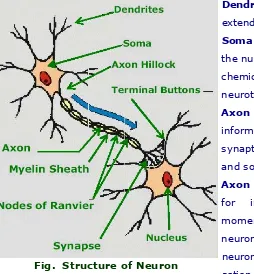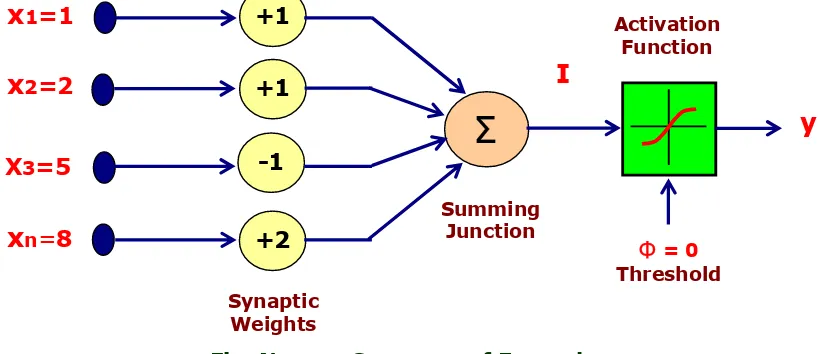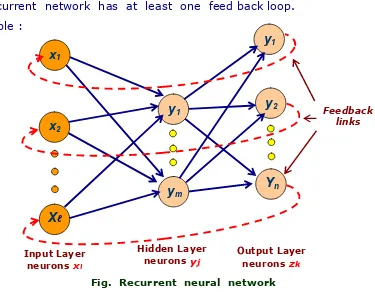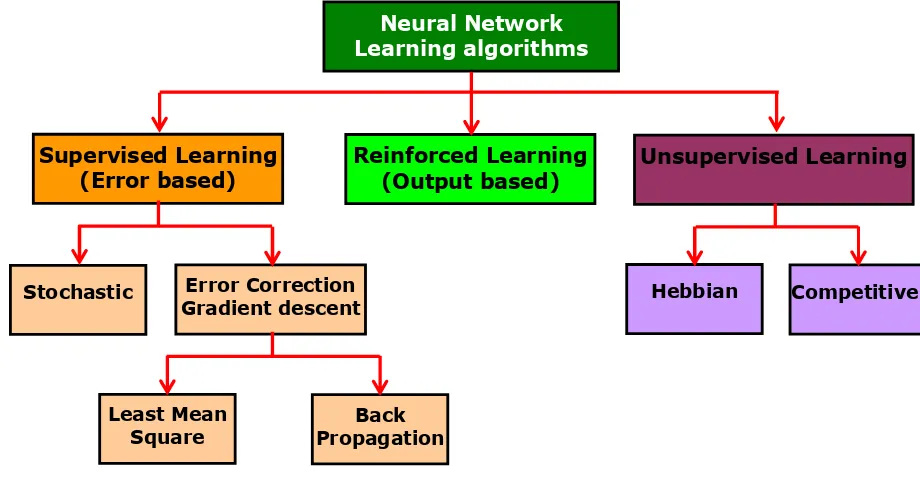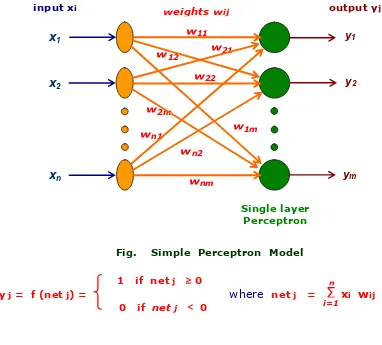RC Ch akrab
orty, www.myread ers.in
Fundamentals of Neural Networks : AI Course lecture 37 – 38, notes, slides
www.myreaders.info/ , RC Chakraborty, e-mail [email protected] , June 01, 2010 www.myreaders.info/html/artificial_intelligence.html
Fundamentals of Neural Networks
Artificial Intelligence
www.myreaders.info
Return to Website
Neural network, topics : Introduction, biological neuron model,
artificial neuron model, notations, functions; Model of artificial
neuron - McCulloch-Pitts neuron equation; Artificial neuron – basic
elements, activation functions, threshold function, piecewise linear
function, sigmoidal function; Neural network architectures - single
layer feed-forward network, multi layer feed-forward network,
recurrent networks; Learning Methods in Neural Networks -
classification of learning algorithms, supervised learning,
unsupervised learning, reinforced learning, Hebbian learning,
gradient descent learning, competitive learning, stochastic
learning. Single-Layer NN System - single layer perceptron ,
learning algorithm for training, linearly separable task, XOR
Problem, learning algorithm, ADAptive LINear Element (ADALINE)
architecture and training mechanism; Applications of neural
networks - clustering, classification, pattern recognition, function
RC Ch akrab
orty, www.myread ers.in
Fundamentals of Neural Networks
Artificial Intelligence
Topics
(Lectures 37, 38 2 hours) Slides
1. Introduction
Why neural network ?, Research history, Biological neuron model,
Artificial neuron model, Notations, Functions.
03-12
2. Model of Artificial Neuron
McCulloch-Pitts Neuron Equation, Artificial neuron – basic elements,
Activation functions – threshold function, piecewise linear function,
sigmoidal function.
13-19
3. Neural Network Architectures
Single layer feed-forward network, Multi layer feed-forward network,
Recurrent networks.
20-23
4 Learning Methods in Neural Networks
Classification of learning algorithms, Supervised learning, Unsupervised
learning, Reinforced learning, Hebbian Learning, Gradient descent
learning, Competitive learning, Stochastic learning.
24-29
5. Single-Layer NN System
Single layer perceptron : learning algorithm for training, linearly
separable task, XOR Problem, learning algorithm; ADAptive LINear
Element (ADALINE) : architecture, training mechanism
30-36
6. Applications of Neural Networks
Clustering, Classification / pattern recognition, Function approximation,
Prediction systems.
37
7. References : 38
RC Ch akrab
orty, www.myread ers.in
Neural Networks
What is Neural Net ?
•
A neural net is an artificial representation of the human brain thattries to simulate its learning process. An artificial neural network
(ANN) is often called a "Neural Network" or simply Neural Net (NN).
•
Traditionally, the word neural network is referred to a network ofbiological neurons in the nervous system that process and transmit
information.
•
Artificial neural network is an interconnected group of artificial neuronsthat uses a mathematical model or computational model for information
processing based on a connectionist approach to computation.
•
The artificial neural networks are made of interconnecting artificialneurons which may share some properties of biological neural networks.
•
Artificial Neural network is a network of simple processing elements(neurons) which can exhibit complex global behavior, determined by the
connections between the processing elements and element parameters.
•
Artificial neural network is an adaptive system that changes itsstructure based on external or internal information that flows
through the network.
RC Ch akrab
orty, www.myread ers.in
AI-Neural Network – Introduction
1. Introduction
Neural Computers mimic certain processing capabilities of the human brain.
- Neural Computing is an information processing paradigm, inspired by
biological system, composed of a large number of highly interconnected
processing elements (neurons) working in unison to solve specific problems.
- Artificial Neural Networks (ANNs), like people, learn by example.
- An ANN is configured for a specific application, such as pattern recognition or
data classification, through a learning process.
- Learning in biological systems involves adjustments to the synaptic
connections that exist between the neurons. This is true of ANNs as well.
RC Ch akrab
orty, www.myread ers.in
AI-Neural Network – Introduction
1.1 Why Neural Network
■ The conventional computers are good for - fast arithmetic and does
what programmer programs, ask them to do.
■ The conventional computers are not so good for - interacting with
noisy data or data from the environment, massive parallelism, fault
tolerance, and adapting to circumstances.
■ The neural network systems help where we can not formulate an
algorithmic solution or where we can get lots of examples of the
behavior we require.
■ Neural Networks follow different paradigm for computing.
The von Neumann machines are based on the processing/memory
abstraction of human information processing.
The neural networks are based on the parallel architecture of
biological brains.
■ Neural networks are a form of multiprocessor computer system, with
- simple processing elements ,
- a high degree of interconnection,
- simple scalar messages, and
- adaptive interaction between elements.
RC Ch akrab
orty, www.myread ers.in
AI-Neural Network – Introduction
1.2 Research History
The history is relevant because for nearly two decades the future of
Neural network remained uncertain.
McCulloch and Pitts (1943) are generally recognized as the designers of the
first neural network. They combined many simple processing units together
that could lead to an overall increase in computational power. They
suggested many ideas like : a neuron has a threshold level and once that
level is reached the neuron fires. It is still the fundamental way in which
ANNs operate. The McCulloch and Pitts's network had a fixed set of weights.
Hebb (1949) developed the first learning rule, that is if two neurons are
active at the same time then the strength between them should be
increased.
In the 1950 and 60's, many researchers (Block, Minsky, Papert, and
Rosenblatt worked on perceptron. The neural network model could be
proved to converge to the correct weights, that will solve the problem. The
weight adjustment (learning algorithm) used in the perceptron was found
more powerful than the learning rules used by Hebb. The perceptron caused
great excitement. It was thought to produce programs that could think.
Minsky & Papert (1969) showed that perceptron could not learn those
functions which are not linearly separable.
The neural networks research declined throughout the 1970 and until mid
80's because the perceptron could not learn certain important functions.
Neural network regained importance in 1985-86. The researchers, Parker
and LeCun discovered a learning algorithm for multi-layer networks called
back propagation that could solve problems that were not linearly
separable.
06
RC Ch
The human brain consists of a large number, more than a billion of
neural cells that process information. Each cell works like a simple
processor. The massive interaction between all cells and their parallel
processing only makes the brain's abilities possible.
Fig. Structure of Neuron
Dendrites are branching fibers that
extend from the cell body or soma.
Soma or cell body of a neuron contains
the nucleus and other structures, support
chemical processing and production of
neurotransmitters.
Axon is a singular fiber carries
information away from the soma to the
synaptic sites of other neurons (dendrites
and somas), muscles, or glands.
Axon hillock is the site of summation
for incoming information. At any
moment, the collective influence of all
neurons that conduct impulses to a given
neuron will determine whether or not an
action potential will be initiated at the
axon hillock and propagated along the axon.
Myelin Sheath consists of fat-containing cells that insulate the axon from electrical
activity. This insulation acts to increase the rate of transmission of signals. A gap
exists between each myelin sheath cell along the axon. Since fat inhibits the
propagation of electricity, the signals jump from one gap to the next.
Nodes of Ranvier are the gaps (about 1 µm) between myelin sheath cells long axons
are Since fat serves as a good insulator, the myelin sheaths speed the rate of
transmission of an electrical impulse along the axon.
Synapse is the point of connection between two neurons or a neuron and a muscle or
a gland. Electrochemical communication between neurons takes place at these
junctions.
Terminal Buttons of a neuron are the small knobs at the end of an axon that release
chemicals called neurotransmitters.
07
RC Ch akrab
orty, www.myread ers.in
AI-Neural Network – Introduction
•
Information flow in a Neural CellThe input /output and the propagation of information are shown below.
Structure of a Neural Cell in the Human Brain
■ Dendrites receive activation from other neurons.
■ Soma processes the incoming activations and converts them into
output activations.
■ Axons act as transmission lines to send activation to other neurons.
■ Synapses the junctions allow signal transmission between the
axons and dendrites.
■ The process of transmission is by diffusion of chemicals called
neuro-transmitters.
McCulloch-Pitts introduced a simplified model of this real neurons.
RC Ch akrab
orty, www.myread ers.in
AI-Neural Network – Introduction
1.4 Artificial Neuron Model
An artificial neuron is a mathematical function conceived as a simple
model of a real (biological) neuron.
•
The McCulloch-Pitts NeuronThis is a simplified model of real neurons, known as a Threshold Logic Unit.
Input1
Input 2
Input n
■ A set of input connections brings in activations from other neurons.
■ A processing unit sums the inputs, and then applies a non-linear
activation function (i.e. squashing / transfer / threshold function).
■ An output line transmits the result to other neurons.
In other words ,
- The input to a neuron arrives in the form of signals.
- The signals build up in the cell.
- Finally the cell discharges (cell fires) through the output .
- The cell can start building up signals again.
09
Σ
RC Ch akrab
orty, www.myread ers.in
AI-Neural Network – Introduction
1.5 Notations
Recaps : Scalar, Vectors, Matrices and Functions
•
Scalar : The number xi can be added up to give a scalar number.s = x1 + x2 + x3 + . . . . + xn = xi
•
Vectors : An ordered sets of related numbers. Row Vectors (1 x n)X = ( x1 , x2 , x3 , . . ., xn ) , Y = ( y1 , y2 , y3 , . . ., yn )
Add : Two vectors of same length added to give another vector.
Z = X + Y = (x1 + y1 , x2 + y2 , . . . . , xn + yn)
Multiply: Two vectors of same length multiplied to give a scalar.
p = X . Y = x1 y1 + x2 y2 + . . . . + xnyn = xi yi
Σ
i=1 n
Σ
RC Ch
Add or Subtract : Matrices of the same size are added or subtracted
RC Ch
The Function y= f(x) describes a relationship, an input-output mapping,
from x to y.
(differentiable) form of the threshold function
RC Ch akrab
orty, www.myread ers.in
AI-Neural Network – Model of Neuron
2. Model of Artificial Neuron
A very simplified model of real neurons is known as a Threshold Logic
Unit (TLU). The model is said to have :
- A set of synapses (connections) brings in activations from other neurons.
- A processing unit sums the inputs, and then applies a non-linear activation
function (i.e. squashing / transfer / threshold function).
- An output line transmits the result to other neurons.
2.1 McCulloch-Pitts (M-P) Neuron Equation
McCulloch-Pitts neuron is a simplified model of real biological neuron.
Input 1
In this McCulloch-Pitts neuron model, the missing features are :
- Non-binary input and output,
- Non-linear summation,
- Smooth thresholding,
- Stochastic, and
- Temporal information processing.
RC Ch akrab
orty, www.myread ers.in
AI-Neural Network – Model Neuron
2.2 Artificial Neuron - Basic Elements
Neuron consists of three basic components - weights, thresholds, and a
single activation function.
Fig Basic Elements of an Artificial Linear Neuron
■ Weighting Factors w
The values w1 , w2 , . . . wn are weights to determine the strength of
input vector X = [x1 , x2 , . . . , xn]T. Each input is multiplied by the
associated weight of the neuron connection XT W. The +ve weight
excites and the -ve weight inhibits the node output.
I = XT.W = x1 w1 + x2 w2 + . . . . + xnwn = xi wi
■ ThresholdΦ
The node’s internal threshold Φ is the magnitude offset. It affects the
activation of the node output y as:
Y = f (I) = f { xi wi
-
Φk }To generate the final output Y , the sum is passed on to a non-linear
filter f called Activation Function or Transfer function or Squash function
which releases the output Y.
RC Ch akrab
orty, www.myread ers.in
AI-Neural Network – Model of Neuron
■ Threshold for a Neuron
In practice, neurons generally do not fire (produce an output) unless
their total input goes above a threshold value.
The total input for each neuron is the sum of the weighted inputs
to the neuron minus its threshold value. This is then passed through
the sigmoid function. The equation for the transition in a neuron is :
a = 1/(1 + exp(- x)) where
x = ai wi - Q
a is the activation for the neuron
ai is the activation for neuron i
wi is the weight
Q is the threshold subtracted
■ Activation Function
An activation function f performs a mathematical operation on the
signal output. The most common activation functions are:
- Linear Function,
- Piecewise Linear Function,
- Tangent hyperbolic function
- Threshold Function,
- Sigmoidal (S shaped) function,
The activation functions are chosen depending upon the type of
problem to be solved by the network.
15
Σ
RC Ch akrab
orty, www.myread ers.in
AI-Neural Network – Model of Neuron
2.2 Activation Functions f - Types
Over the years, researches tried several functions to convert the input into
an outputs. The most commonly used functions are described below.
- I/P Horizontal axis shows sum of inputs .
- O/P Vertical axis shows the value the function produces ie output.
- All functions f are designed to produce values between 0 and 1.
•
Threshold FunctionA threshold (hard-limiter) activation function is either a binary type or
a bipolar type as shown below.
binary threshold
O/p
I/P
Output of a binary threshold function produces :
Output of a bipolar threshold function produces :
1 if the weighted sum of the inputs is +ve,
-1 if the weighted sum of the inputs is -ve.
1 if I ≥ 0 Y = f (I) =
-1 if I < 0
Neuron with hard limiter activation function is called McCulloch-Pitts model.
1
1
RC Ch akrab
orty, www.myread ers.in
AI-Neural Network – Model of Neuron
•
Piecewise Linear FunctionThis activation function is also called saturating linear function and can
have either a binary or bipolar range for the saturation limits of the output.
The mathematical model for a symmetric saturation function is described
below.
Piecewise Linear
O/p
I/P
This is a sloping function that produces :
-1 for a -ve weighted sum of inputs,
1 for a +ve weighted sum of inputs.
∝
Iproportional to input for values between +1
and -1 weighted sum,
1 if I ≥ 0
Y = f (I) = I if -1 ≥ I ≥ 1
-1 if I < 0
17
+1
RC Ch akrab
orty, www.myread ers.in
AI-Neural Network – Model of Neuron
•
Sigmoidal Function (S-shape function)The nonlinear curved S-shape function is called the sigmoid function.
This is most common type of activation used to construct the neural
networks. It is mathematically well behaved, differentiable and strictly
increasing function.
Sigmoidal function
A sigmoidal transfer function can be
written in the form:
1
α is slope parameter also called shape parameter; symbol the λ is also used to
represented this parameter.
The sigmoidal function is achieved using exponential equation.
By varying
α
different shapes of the function can be obtained which
adjusts the abruptness of the function as it changes between the two
asymptotic values.
RC Ch akrab
orty, www.myread ers.in
AI-Neural Network – Model of Neuron
•
Example :
The neuron shown consists of four inputs with the weights.
Fig Neuron Structure of Example
The output I of the network, prior to the activation function stage, is
With a binary activation function the outputs of the neuron is:
RC Ch akrab
orty, www.myread ers.in
AI-Neural Network – Architecture
3. Neural Network Architectures
An Artificial Neural Network (ANN) is a data processing system, consisting
large number of simple highly interconnected processing elements as
artificial neuron in a network structure that can be represented using a
directed graph G, an ordered 2-tuple (V, E) , consisting a set V of vertices
and a set E of edges.
- The vertices may represent neurons (input/output) and
- The edges may represent synaptic links labeled by the weights attached.
Example :
Fig. Directed Graph
Vertices V = { v1 , v2 , v3 , v4, v5 }
Edges E = { e1 , e2 , e3 , e4, e5 }
V
1V
3V
2V
4V
5e3 e2 e5
e4
RC Ch akrab
orty, www.myread ers.in
AI-Neural Network – Architecture
3.1 Single Layer Feed-forward Network
The Single Layer Feed-forward Network consists of a single layer of
weights , where the inputs are directly connected to the outputs, via a
series of weights. The synaptic links carrying weights connect every input
to every output , but not other way. This way it is considered a network of
feed-forward type. The sum of the products of the weights and the inputs is calculated in each neuron node, and if the value is above some threshold
(typically 0) the neuron fires and takes the activated value (typically 1);
otherwise it takes the deactivated value (typically -1).
RC Ch akrab
orty, www.myread ers.in
AI-Neural Network – Architecture
3.2 Multi Layer Feed-forward Network
The name suggests, it consists of multiple layers. The architecture of
this class of network, besides having the input and the output layers,
also have one or more intermediary layers called hidden layers. The
computational units of the hidden layer are known as hidden neurons.
Fig. Multilayer feed-forward network in (ℓ– m – n) configuration.
- The hidden layer does intermediate computation before directing the input to output layer.
- The input layer neurons are linked to the hidden layer neurons; the weights on these links are referred to as input-hidden layer weights.
- The hidden layer neurons and the corresponding weights are referred to as output-hidden layer weights.
- A multi-layer feed-forward network with ℓ input neurons, m1 neurons in
the first hidden layers, m2 neurons in the second hidden layers, and n
output neurons in the output layers is written as (ℓ - m1 - m2 – n ).
- Fig. above illustrates a multilayer feed-forward network with a
RC Ch akrab
orty, www.myread ers.in
AI-Neural Network – Architecture
3.3 Recurrent Networks
The Recurrent Networks differ from feed-forward architecture.
A Recurrent network has at least one feed back loop.
Example :
Fig. Recurrent neural network
There could be neurons with self-feedback links;
that is the output of a neuron is feedback into itself as input.
23
x
1x
2X
ℓy
2y
1Y
ny
1y
mHidden Layer neurons yj
Output Layer neuronszk
Input Layer neurons xi
RC Ch akrab
orty, www.myread ers.in
AI-Neural Network –Learning methods
4. Learning methods in Neural Networks
The learning methods in neural networks are classified into three basic types :
- Supervised Learning,
- Unsupervised Learning
- Reinforced Learning
These three types are classified based on :
- presence or absence of teacher and
- the information provided for the system to learn.
These are further categorized, based on the rules used, as
- Hebbian,
- Gradient descent,
- Competitive
- Stochastic learning.
RC Ch akrab
orty, www.myread ers.in
AI-Neural Network –Learning methods Classification of Learning Algorithms
Fig. below indicate the hierarchical representation of the algorithms mentioned
in the previous slide. These algorithms are explained in subsequent slides.
Fig. Classification of learning algorithms
25
Neural Network Learning algorithms
Unsupervised Learning Supervised Learning
(Error based)
Reinforced Learning (Output based)
Error Correction Gradient descent Stochastic
Back Propagation Least Mean
Square
RC Ch akrab
orty, www.myread ers.in
AI-Neural Network –Learning methods
•
Supervised Learning- A teacher is present during learning process and presents
expected output.
- Every input pattern is used to train the network.
- Learning process is based on comparison, between network's
computed output and the correct expected output, generating "error".
- The "error" generated is used to change network parameters that
result improved performance.
•
Unsupervised Learning- No teacher is present.
- The expected or desired output is not presented to the network.
- The system learns of it own by discovering and adapting to the
structural features in the input patterns.
•
Reinforced Learning- A teacher is present but does not present the expected or desired
output but only indicated if the computed output is correct or incorrect.
- The information provided helps the network in its learning process.
- A reward is given for correct answer computed and a penalty for a wrong
answer.
Note : The Supervised and Unsupervised learning methods are most popular
RC Ch akrab
orty, www.myread ers.in
AI-Neural Network –Learning methods
•
Hebbian LearningHebb proposed a rule based on correlative weight adjustment.
In this rule, the input-output pattern pairs (Xi , Yi) are associated by
the weight matrix W, known as correlation matrix computed as
W = Xi YiT
where YiT is the transpose of the associated output vector Yi
There are many variations of this rule proposed by the other
researchers (Kosko, Anderson, Lippman) .
27
Σ
RC Ch akrab
orty, www.myread ers.in
AI-Neural Network –Learning methods
•
Gradient Descent LearningThis is based on the minimization of errors E defined in terms of weights
and the activation function of the network.
- Here, the activation function of the network is required to be
differentiable, because the updates of weight is dependent on
the gradient of the error E.
- If ∆ Wij is the weight update of the link connecting the i th and the j th
neuron of the two neighboring layers, then ∆ Wij is defined as
∆ Wij = η (∂ E / ∂ Wij )
where η is the learning rate parameters and(∂ E / ∂ Wij ) is error
gradient with reference to the weight Wij .
Note : The Hoffs Delta rule and Back-propagation learning rule are
the examples of Gradient descent learning.
RC Ch akrab
orty, www.myread ers.in
AI-Neural Network –Learning methods
•
Competitive Learning- In this method, those neurons which respond strongly to the input
stimuli have their weights updated.
- When an input pattern is presented, all neurons in the layer compete,
and the winning neuron undergoes weight adjustment .
- This strategy is called "winner-takes-all".
•
Stochastic learning- In this method the weights are adjusted in a probabilistic fashion.
- Example : Simulated annealing which is a learning mechanism
employed by Boltzmann and Cauchy machines.
RC Ch akrab
orty, www.myread ers.in
AI-Neural Network –Single Layer learning
5. Single-Layer NN Systems
Here, a simple Perceptron Model and an ADALINE Network Model is presented.
5.1 Single Layer Perceptron
Definition : An arrangement of one input layer of neurons feed forward
to one output layer of neurons is known as Single Layer Perceptron.
RC Ch akrab
orty, www.myread ers.in
AI-Neural Network –Single Layer learning
•
Learning Algorithm for Training PerceptronThe training of Perceptron is a supervised learning algorithm where
weights are adjusted to minimize error when ever the output does
not match the desired output.
− If the output is correct then no adjustment of weights is done.
i.e. =
− If the output is 1 but should have been 0 then the weights are
decreased on the active input link
i.e. = − α . xi
− If the output is 0 but should have been 1 then the weights are
increased on the active input link
RC Ch akrab
orty, www.myread ers.in
AI-Neural Network –Single Layer learning
•
Perceptron and Linearly Separable TaskPerceptron can not handle tasks which are not separable.
- Definition : Sets of points in 2-D space are linearly separable if the
sets can be separated by a straight line.
- Generalizing, a set of points in n-dimensional space are linearly
separable if there is a hyper plane of (n-1) dimensions separates
the sets.
Example
S1 S2
S1
S2
(a) Linearly separable patterns (b) Not Linearly separable patterns
Note : Perceptron cannot find weights for classification problems that
RC Ch akrab
orty, www.myread ers.in
AI-Neural Network –Single Layer learning
•
XOR Problem : Exclusive OR operationInput x1 Input x2 Output
0 0 0 1 1 0 0 1 1 1 0 1
XOR truth table
Even parity means even number of 1 bits in the input
Odd parity means odd number of 1 bits in the input
X2
(0, 1) (1, 1)
(0, 0) X1 (0, 1)
Output of XOR in X1 , x2 plane
- There is no way to draw a single straight line so that the circles are on one side of the line and the dots on the other side.
- Perceptron is unable to find a line separating even parity input patterns from odd parity input patterns.
33
•
°
•
°
Even parity •
RC Ch akrab
orty, www.myread ers.in
AI-Neural Network –Single Layer learning
•
Perceptron Learning AlgorithmThe algorithm is illustrated step-by-step.
■ Step 1 :
Iterate through the input patterns Xj of the training set using the
weight set; ie compute the weighted sum of inputs net j = xi wi
If all the input patterns have been classified correctly, then output
(read) the weights and exit.
■ Step 6 :
Otherwise, update the weights as given below :
RC Ch akrab
orty, www.myread ers.in
AI-Neural Network –ADALINE
5.2 ADAptive LINear Element (ADALINE)
An ADALINE consists of a single neuron of the McCulloch-Pitts type,
where its weights are determined by the normalized least mean
square (LMS) training law. The LMS learning rule is also referred to as
delta rule. It is a well-established supervised training method that
has been used over a wide range of diverse applications.
•
Architecture of a simple ADALINE
The basic structure of an ADALINE is similar to a neuron with a
linear activation function and a feedback loop. During the training
phase of ADALINE, the input vector as well as the desired output
are presented to the network.
[The complete training mechanism has been explained in the next slide.]
35
W1
Σ
W2
Wn
Σ
x
1x
2x
nNeuron
Error
Desired Output Output
–
RC Ch akrab
orty, www.myread ers.in
AI-Neural Network –ADALINE
•
ADALINE Training Mechanism(Ref. Fig. in the previous slide - Architecture of a simple ADALINE)
■ The basic structure of an ADALINE is similar to a linear neuron
with an extra feedback loop.
■ During the training phase of ADALINE, the input vector
X = [x1 , x2 , . . . , xn]T as well as desired output are presented
to the network.
■ The weights are adaptively adjusted based on delta rule.
■ After the ADALINE is trained, an input vector presented to the
network with fixed weights will result in a scalar output.
■ Thus, the network performs an n dimensional mapping to a
scalar value.
■ The activation function is not used during the training phase.
Once the weights are properly adjusted, the response of the
trained unit can be tested by applying various inputs, which are
not in the training set. If the network produces consistent
responses to a high degree with the test inputs, it is said
that the network could generalize. The process of training and
generalization are two important attributes of this network.
Usage of ADLINE :
In practice, an ADALINE is used to
- Make binary decisions; the output is sent through a binary threshold.
- Realizations of logic gates such as AND, NOT and OR .
RC Ch akrab
orty, www.myread ers.in
AI-Neural Network –Applications
6. Applications of Neural Network
Neural Network Applications can be grouped in following categories:
■ Clustering:
A clustering algorithm explores the similarity between patterns and
places similar patterns in a cluster. Best known applications include
data compression and data mining.
■ Classification/Pattern recognition:
The task of pattern recognition is to assign an input pattern
(like handwritten symbol) to one of many classes. This category
includes algorithmic implementations such as associative memory.
■ Function approximation :
The tasks of function approximation is to find an estimate of the
unknown function subject to noise. Various engineering and scientific
disciplines require function approximation.
■ Prediction Systems:
The task is to forecast some future values of a time-sequenced
data. Prediction has a significant impact on decision support systems.
Prediction differs from function approximation by considering time factor.
System may be dynamic and may produce different results for the
same input data based on system state (time).
RC Ch akrab
orty, www.myread ers.in
AI-AI-Neural Network –References
7. References : Textbooks
1. "Neural Networks: A Comprehensive Foundation", by Simon S. Haykin, (1999), Prentice Hall, Chapter 1-15, page 1-889.
2. "Elements of Artificial Neural Networks", by Kishan Mehrotra, Chilukuri K. Mohan and Sanjay Ranka, (1996), MIT Press, Chapter 1-7, page 1-339.
3. "Fundamentals of Neural Networks: Architecture, Algorithms and Applications", by Laurene V. Fausett, (1993), Prentice Hall, Chapter1-7, page 1-449.
4. "Neural Network Design", by Martin T. Hagan, Howard B. Demuth and Mark Hudson Beale, ( 1996) , PWS Publ. Company, Chapter 1-19, page 1-1 to 19-14.
5. "An Introduction to Neural Networks", by James A. Anderson, (1997), MIT Press, Chapter 1- 17, page 1-585.
6. "AI: A New Synthesis", by Nils J. Nilsson, (1998), Morgan Kaufmann Inc., Chapter 3, Page 37-48.
7. Related documents from open source, mainly internet. An exhaustive list is being prepared for inclusion at a later date.
